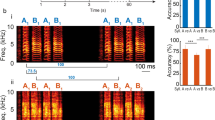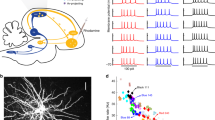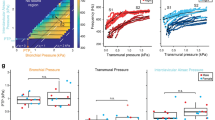Abstract
Birdsong is characterized by the modulation of sound properties over a wide range of timescales1. Understanding the mechanisms by which the brain organizes this complex temporal behaviour is a central motivation in the study of the song control and learning system2,3,4,5,6,7,8. Here we present evidence that, in addition to central neural control, a further level of temporal organization is provided by nonlinear oscillatory dynamics that are intrinsic to the avian vocal organ. A detailed temporal and spectral examination of song of the zebra finch (Taeniopygia guttata) reveals a class of rapid song modulations that are consistent with transitions in the dynamical state of the syrinx. Furthermore, in vitro experiments show that the syrinx can produce a sequence of oscillatory states that are both spectrally and temporally complex in response to the slow variation of respiratory or syringeal parameters. As a consequence, simple variations in a small number of neural signals can result in a complex acoustic sequence.
This is a preview of subscription content, access via your institution
Access options
Subscribe to this journal
Receive 51 print issues and online access
$199.00 per year
only $3.90 per issue
Buy this article
- Purchase on Springer Link
- Instant access to full article PDF
Prices may be subject to local taxes which are calculated during checkout




Similar content being viewed by others
References
Greenewalt, C. H. Brid Song: Acoustics and Physiology (Smithsonian Institution Press, Washington DC, (1968)).
Nottebohm, F., Stokes, T. M. & Leonard, C. M. Central control of song in the canary, Serinus canarius. J. Comp. Neurol. 165, 457–486 (1976).
Nottebohm, F., Kelley, D. B. & Paton, J. A. Connections of vocal control nuclei in the canary telencephalon. J. Comp. Neurol. 207(1982).
McCasland, J. S. Neuronal control of bird song production. J. Neurosci. 7, 23–39 (1987).
Scharff, C. & Nottebohm, F. Acomparative study of the behavioral deficits following lesions of various parts of the zebra finch song system: implications for vocal learning. J. Neurosci. 11, 2896–2913 (1991).
Konishi, M. Pattern generation in birdsong. Curr. Opin. Neurobiol. 4, 827–831 (1994).
Vu, E., Mazurek, M. E. & Kuo, Y.-C. Identification of a forebrain motor programming network for the learned song of zebra finches. J. Neurosci. 14, 6924–6934 (1994).
Yu, A. & Margoliash, D. Temporal hierarchical control of singing in birds. Science 273, 1871–1875 (1996).
Immelman, K. in Bird Vocalizations (ed. Hinde, R. A.) pp. 61–74 (Cambridge Univ. Press, (1969)).
Price, P. H. Developmental determinants of structure in zebra finch song. J. Comp. Physiol. Psychol. 93, 260–277 (1979).
Fletcher, N. H. Mode locking in non-linearly excited inharmonic musical oscillators. J. Acoust. Soc. Am. 64, 1566–1569 (1978).
Jackson, E. A. Perspectives of Nonlinear Dynamics (Cambridge Univ. Press, (1992)).
Hartley, R. S. & Suthers, R. A. Airflow and pressure during canary song: direct evidence for mini-breaths. J. Comp. Phys. A 165, 15–26 (1989).
Goller, F. & Suthers, R. A. Implications for lateralization of bird song from unilateral gating of bilateral motor patterns. Nature 373, 63–66 (1995).
Goller, F. & Larsen, O. N. Anew mechanism of sound generation in songbirds. Proc. Natl Acad. Sci. USA 94, 14787–14791 (1997).
Fletcher, N. H. Bird song — a quantitative acoustic model. J. Theor. Biol. 135, 455–481 (1988).
Ishizaka, K. & Flanagan, J. L. Synthesis of voiced sounds from a two-mass model of the vocal cords. Bell Syst. Tech. J. 51, 1233–1268 (1972).
Bertram, C. D. & Pedley, T. J. Amathematical model of unsteady collapsible tube behaviour. J. Biomech. 15, 39–50 (1982).
Berry, D. A., Herzel, H., Titze, I. R. & Krischer, K. Interpretation of biomechanical simulations of normal and chaotic vocal fold oscillations with empirical eigenfunctions. J. Acoust. Soc. Am. 95, 3595–3604 (1994).
Herzel, H., Berry, D. A., Titze, I. R. & Saleh, M. Analysis of vocal disorders with methods from nonlinear dynamics. J. Speech Hear. Res. 37, 1008–1019 (1994).
Thompson, D. J. Spectrum estimation and harmonic analysis. Proc. IEEE 70, 1055–1096 (1982).
Acknowledgements
We thank W. Denk, M. Konishi and S. S.-H. Wang for comments on the manuscript.
Author information
Authors and Affiliations
Corresponding author
Rights and permissions
About this article
Cite this article
Fee, M., Shraiman, B., Pesaran, B. et al. The role of nonlinear dynamics of the syrinx in the vocalizations of a songbird. Nature 395, 67–71 (1998). https://doi.org/10.1038/25725
Received:
Accepted:
Issue Date:
DOI: https://doi.org/10.1038/25725
This article is cited by
-
Bats distress vocalizations carry fast amplitude modulations that could represent an acoustic correlate of roughness
Scientific Reports (2020)
-
Voice breaking and its relation to body mass and testosterone level in the Siberian Crane (Leucogeranus leucogeranus)
Journal of Ornithology (2020)
-
The vocal repertoire of the domesticated zebra finch: a data-driven approach to decipher the information-bearing acoustic features of communication signals
Animal Cognition (2016)
Comments
By submitting a comment you agree to abide by our Terms and Community Guidelines. If you find something abusive or that does not comply with our terms or guidelines please flag it as inappropriate.



